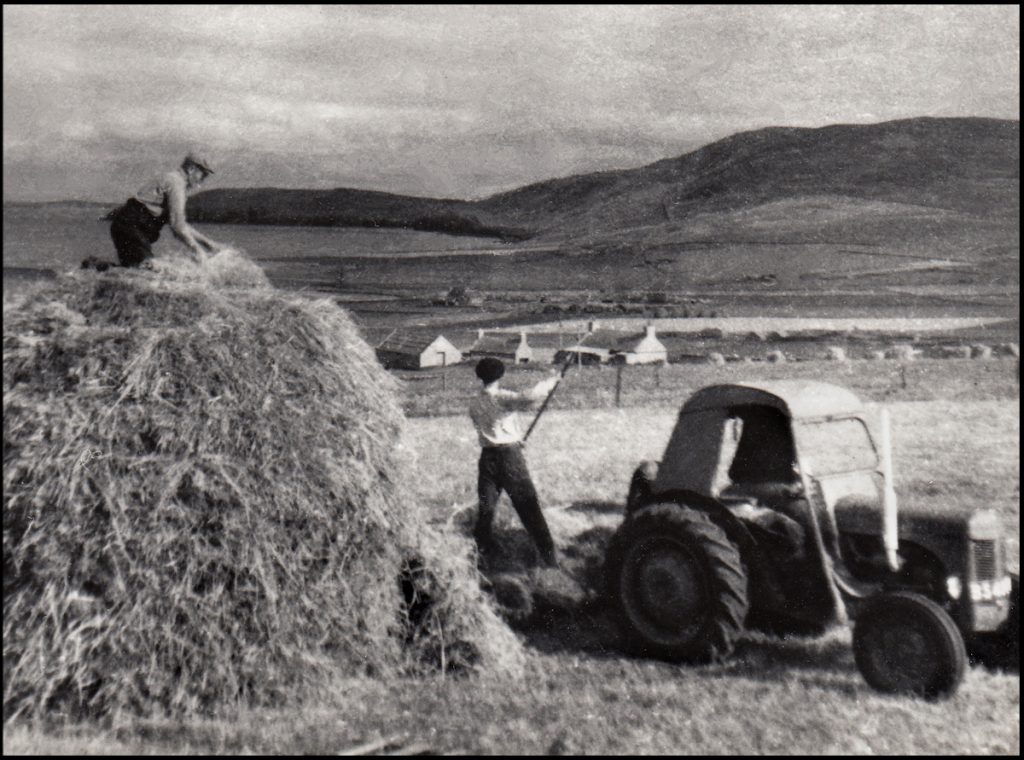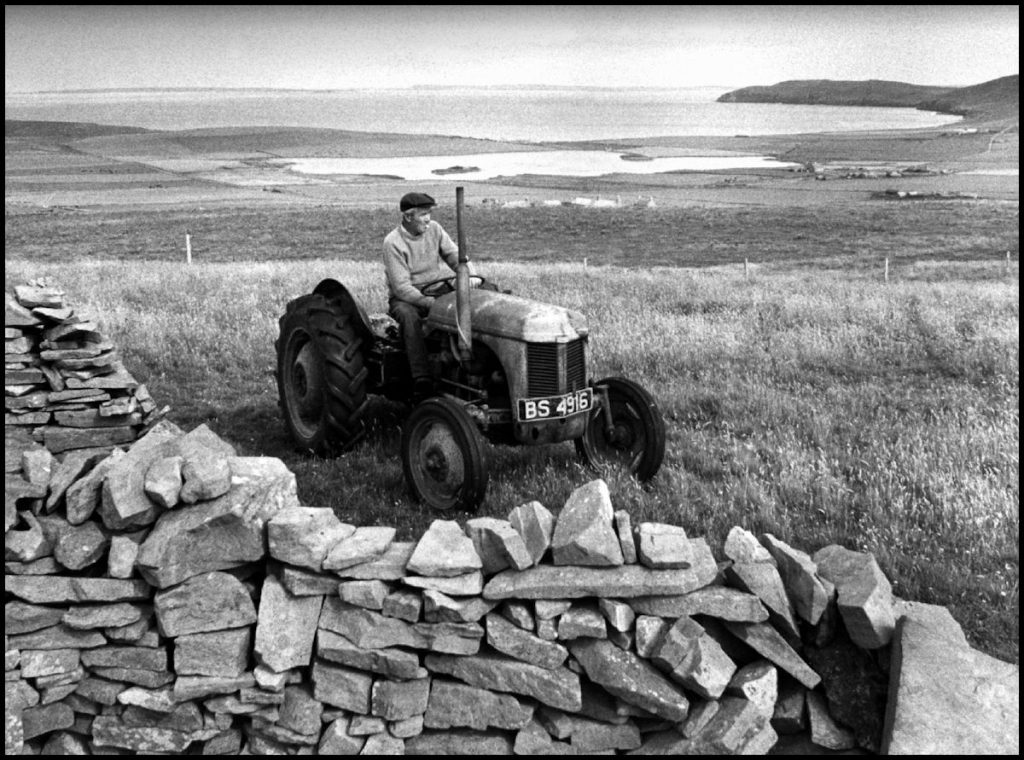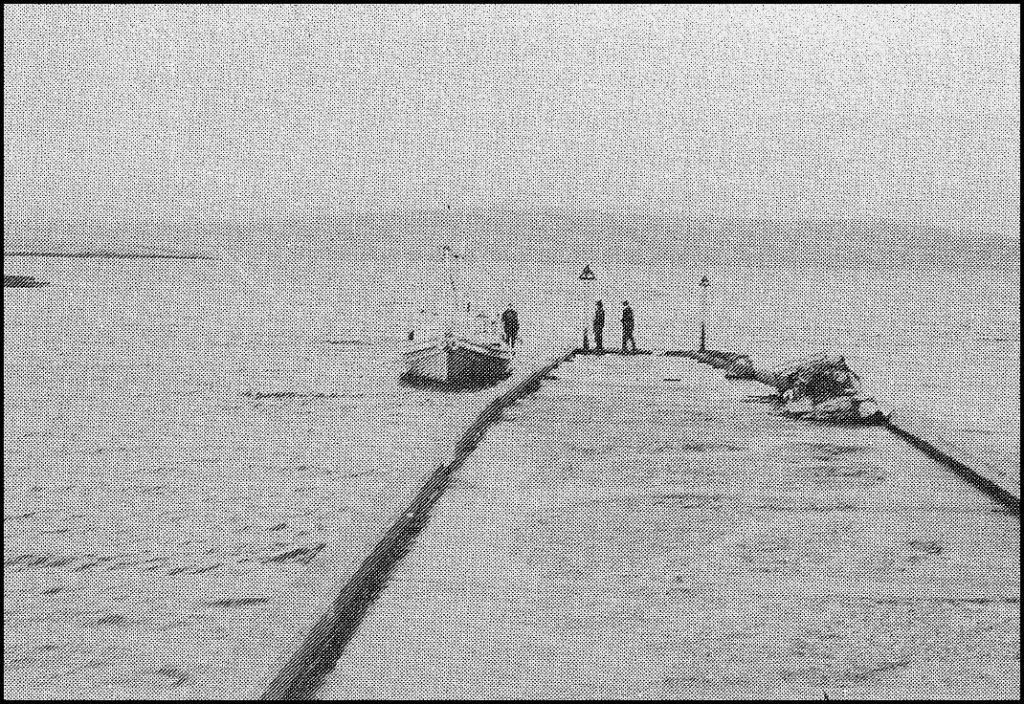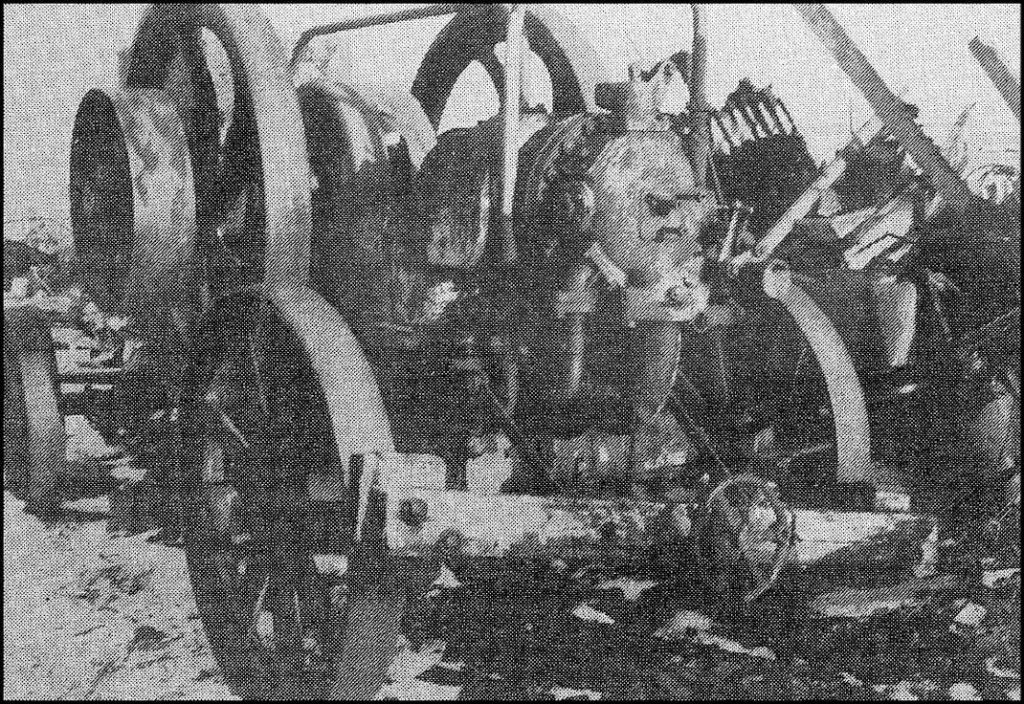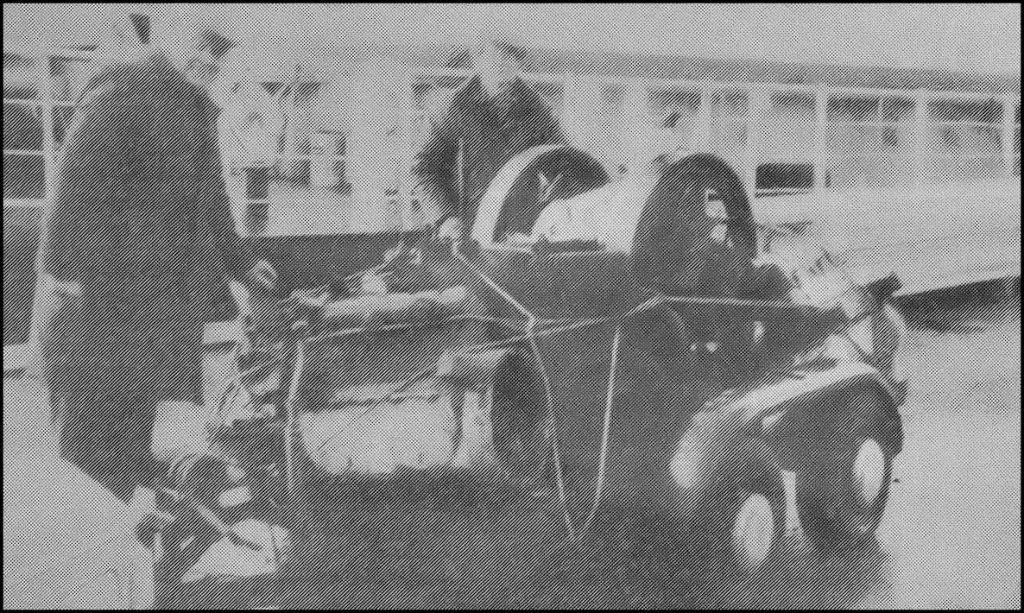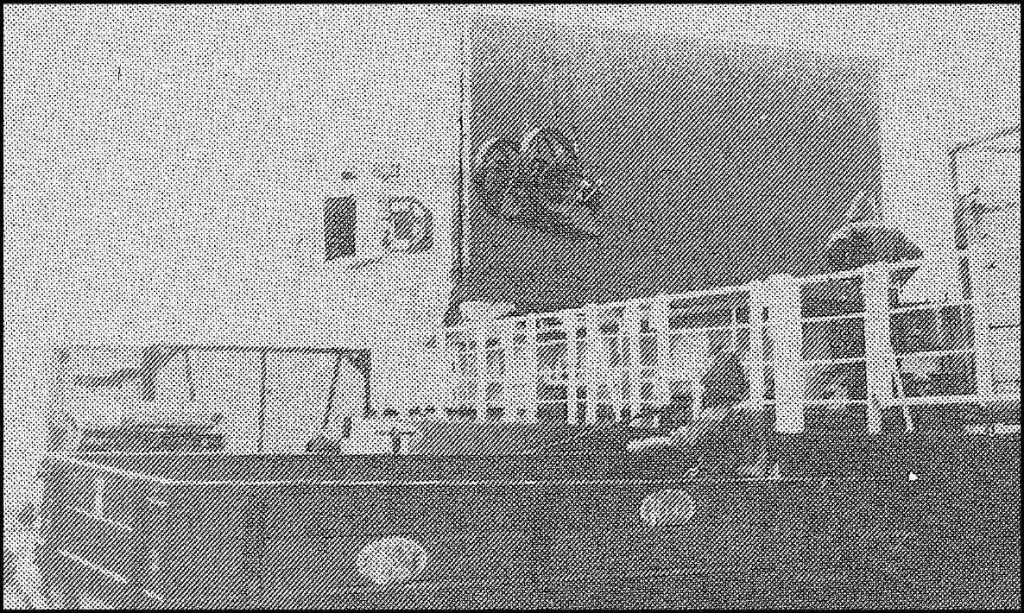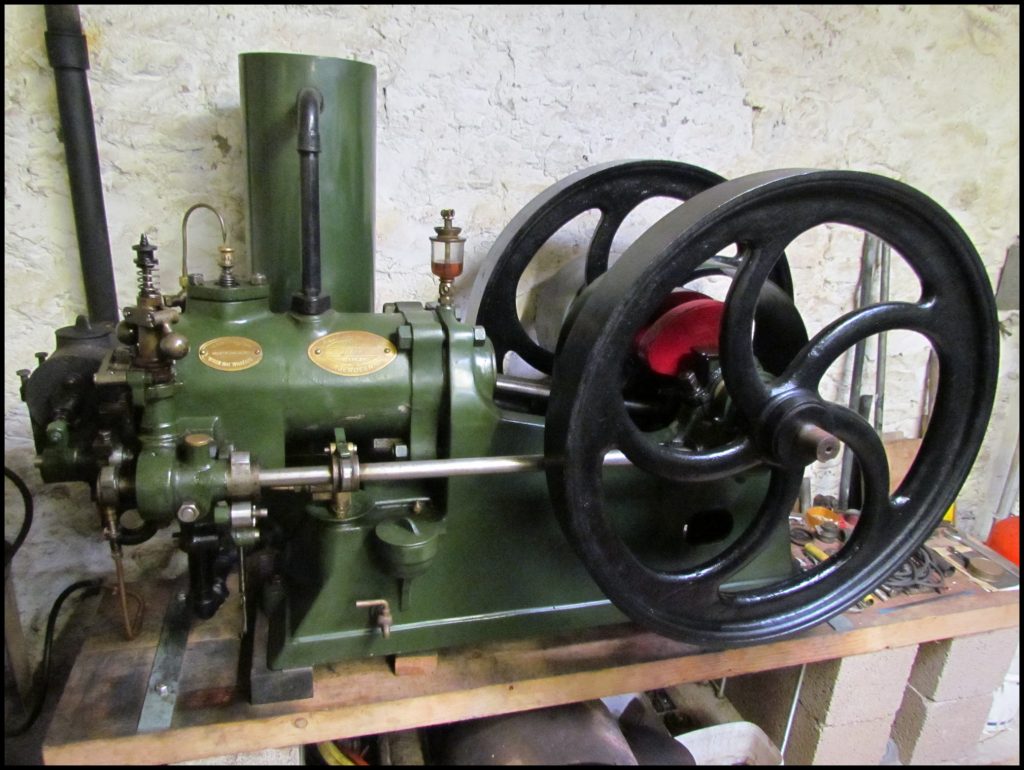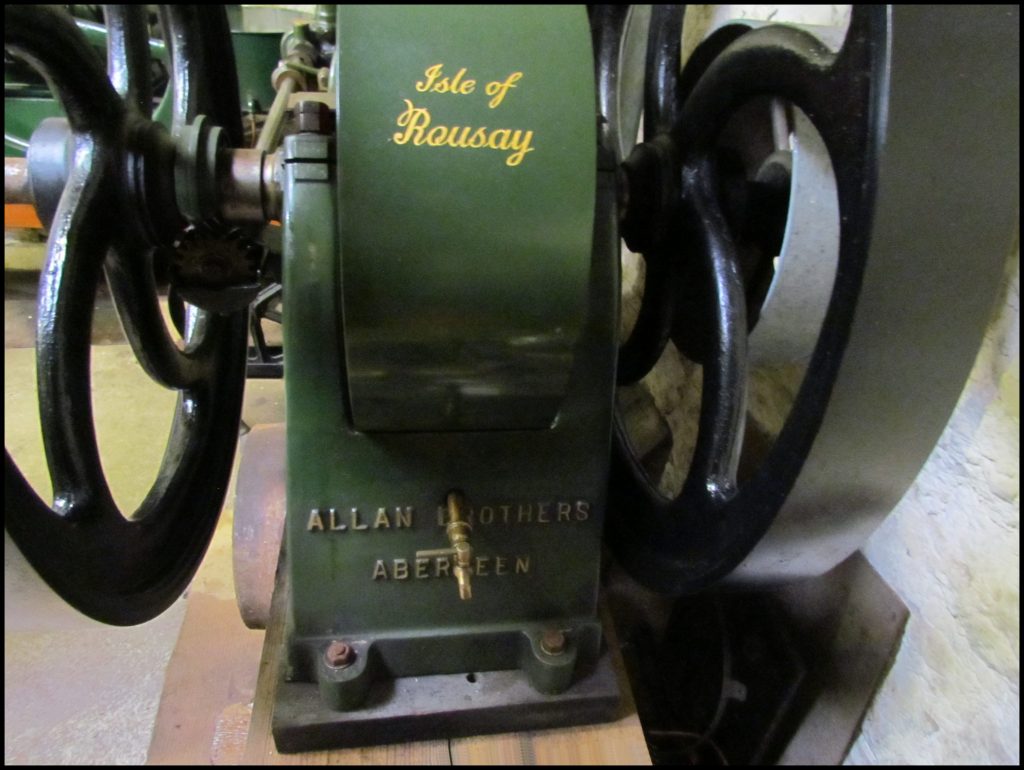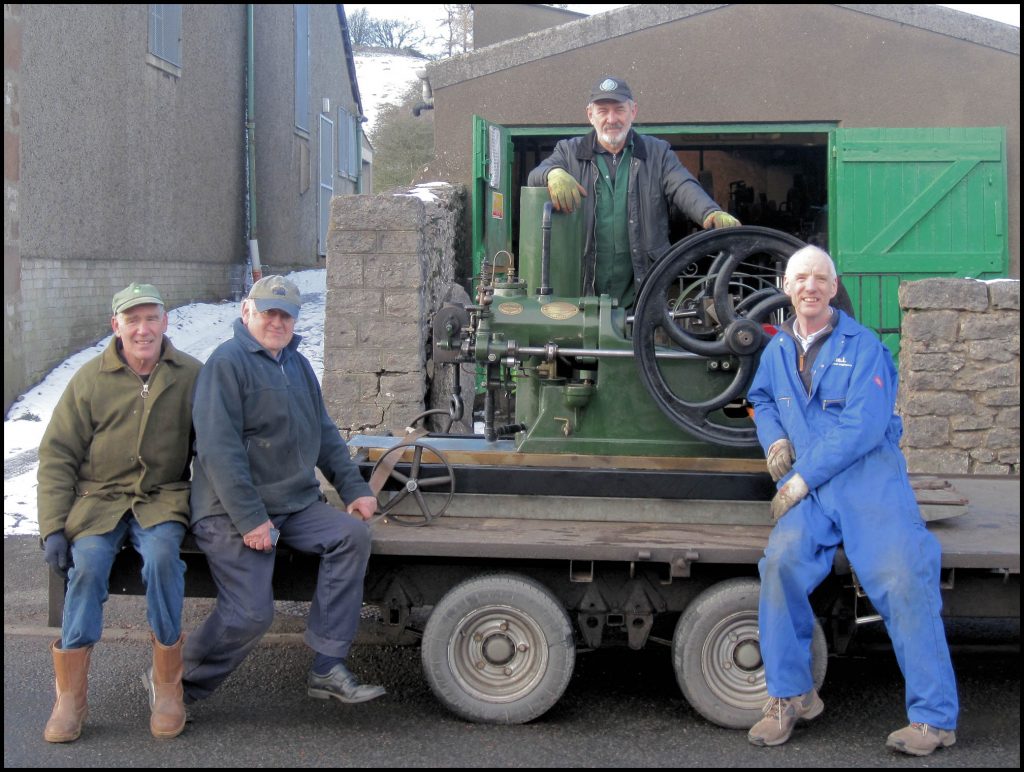William Craigie Flaws farmed the surrounding land at Hammerfield in Wasbister all his working life. Ploughing was done using a grey Fergie, and Ron Spence, Banchory, who used to spend summer holidays in the early 1950s with Bill and wife Mabel, his uncle and aunt, remembers a threshing machine being powered from the back of the tractor via a pulley and belt. Prior to that Bill’s corn box thresher and rollermill were powered by an Allan 3.5 hp 15 cwt lampstart oil engine, which was built in Aberdeen in 1916.
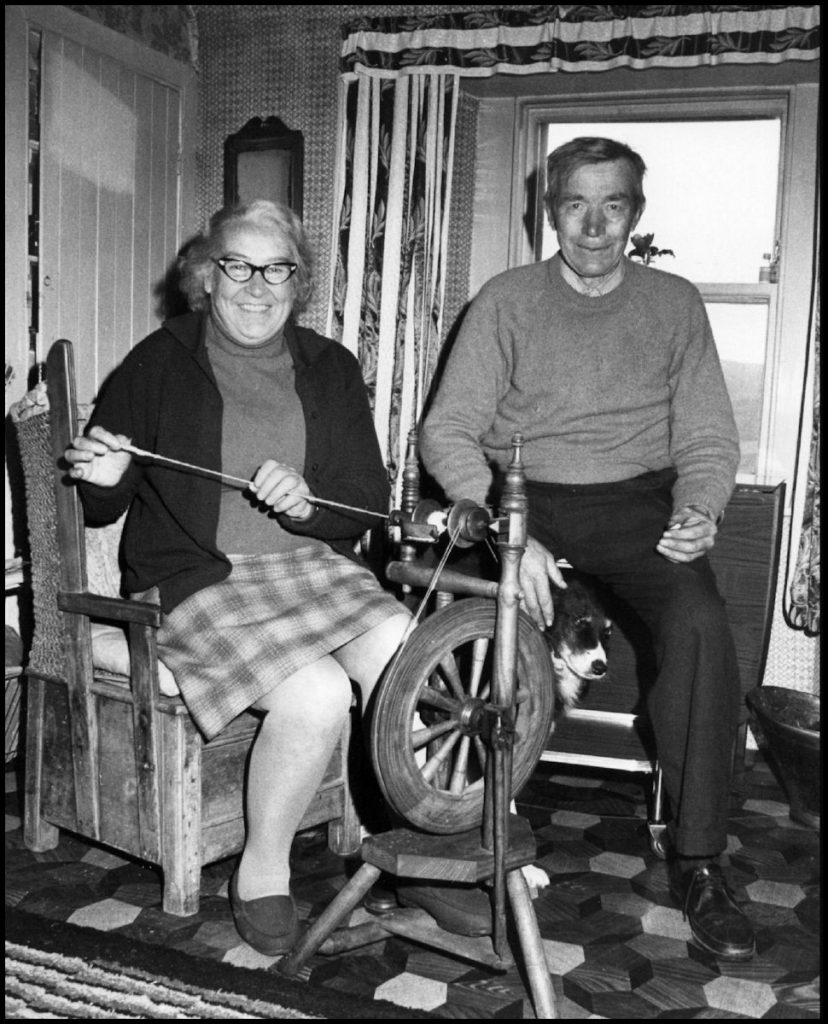
The photos above show Bill building stacks at Hammerfield in the late 1950s – on his grey Fergie at Sunnybraes, and to the right with wife Mabel and dog Spot in 1974.
Bill was 78 years old when he passed away in 1981. Mabel decided to sell up, lock stock and barrel, leaving Rousay for sheltered accommodation at Lambaness, Kirkwall. Cumbria man Arnold Sayer has been interested in vintage engines all his life, and when he heard Bill’s Allan engine was for sale he leapt at the chance of buying it. He travelled to Rousay in November 1982, and with the assistance of Alistair Marwick, Innister, transported the engine to Rousay pier, onto the weekly steamer to Kirkwall – and onwards south.
The engine was in very bad condition when it left the island due to the roof of the old barn in which it was housed being in bad repair, but after a lot of work Arnold managed to get it running again a couple of years later.
The story of Arnold’s trip north and the engine’s renovation featured in an article in Stationary Engine Magazine in 1983. The engine was also used as a prop in a television programme in 1987, and the story of that also featured in the same magazine. Recently Arnold decided to sell the engine, and it passed into the capable hands of enthusiast George Brown, of Coldstream, Berwickshire, who fully intends taking it to rallys and vintage shows in the near future.
George saw the Hammerfield page, and also Ron Spence’s ‘Hammerfield Memories’ on Rousay Remembered. He got in touch, offering the magazine articles and an array of photographs for use on the website – which I am so grateful to him for doing so, for it is such an interesting story.

DESTINATION – THE ORKNEY ISLES
Words – Brian Bowers: Motivation – Arnold Sayer: Photographs – John Harrison
An articulated wagon had jack-knifed on the black ice and blocked the main road – so John and I were travelling along narrow back lanes on an icy Sunday morning in mid November. We were on our way to Arnold’s, who must be crazy, because he intended taking his car and trailer and us to pick up an engine – in the Orkneys somewhere!
Further north the ice changed to rain, then sleet and finally snow which was three or four inches deep near Lanark. Luckily by the time we passed Glasgow the day changed – sunshine though still cold with not a trace of the white stuff. At Pitlochry all the fluid ran out of the car’s suspension at one side. Arnold got quite a bit down his neck as he crawled underneath to wedge a lump of fence post under the rear wheel mountings. Although the car was a little lop-sided it didn’t seem to slow Arnold down very much; his theory was that at 60 m.p.h. the mud flaps didn’t scrape along the road, (we cut them off with a hack-saw later).
We had reached Thurso about 9 o’clock and after a comfortable night went to the ferry terminal at Scrabster on a very cold, bright and breezy morning. By the time we had bought tickets (expensive), loaded up and sailed it was early afternoon and quite wet and windy. Arnold had never been afloat before and after taking his Quells, sat inside with his eyes shut, not daring to move. John was outside – up at the sharp end trying to photograph white water coming over the bows – by this time it was quite rough. I was beginning to feel rather pale myself when the boat turned the corner into Hoy sound and the waves became a lot flatter. With the oncoming dusk and the driving rain John was unable to photograph the ‘Old Man of Hoy’. I couldn’t even see it.
It was quite dark and pouring with rain when we landed at Stromness and after we had found somewhere to eat and walked about the narrow paved (wall to wall) streets of tall houses looking for accommodation we were all damp and cold. During a freezing night – we put our clothes on over our pyjamas – spent at the very top of an old house, listening to the wind and hail on the skylights, we were surprised, next morning, to see the sea only a few yards away on looking out of the window.
Tuesday – travelled across Mainland – which is the biggest island of Orkney, in bright sunlight interspersed with wickedly cold hail showers. Numerous small crofts, each with a few buildings, clusters of small conical oat-stacks and a few sheep. On the better land the grass was surprisingly green. Trees only grow in the shelter of houses.
At Tingwall jetty only 3 ducks were in evidence – it was far too stormy for Mansie Flaws, the ferry-man, to take us to Rousay. Nearby John discovered a smithy and joiners shop, both abandoned but full of gear and tools.
We cruised around noticing a defunct Lister L and a small horizontal Crossley – minus cylinder head. There seemed to be quite a lot of obsolete machinery behind every croft. Arnold phoned the ferryman whenever we passed a phone box but the answer was always the same ‘Its no weather for boats’.
We couldn’t find anywhere to stay in Kirkwall but eventually located a very superior farmhouse for B and B, a couple of miles away, after wandering about a dark and deserted countryside. Spotted a single cylinder Turner diesel outside one place where we stopped to ask the way. Electric blankets and radiators in the bedroom-luxury!
On Wednesday a white world greeted us when looking out. It was bright and windy with the odd snow showers. We’d had a grand ‘crack’ with the farmer the previous night – discussing sheep prices etc. (John and I are farmers) and finally got down to engines. He showed us an old blow-lamp, which Arnold was sure had come from a Campbell engine (made in Halifax) and promised to let us see it.
His son accompanied us and in an old barn, which the farmer had just acquired, was a single fly wheel, lamp-start Campbell – complete and free and in fair condition. There was a rivetted patch on the water jacket and horizontal fly ball governors. It was 5½ feet long and maybe 5 or 6 h.p.
We also visited a local scrap tip to see a big Blackstone portable about 20-25 h.p. which had been working until a few years ago driving a stone crusher in a local quarry. All the brass bearings etc. were missing.
Returning to Tingwall jetty Arnold rang Mansie yet again and the message was “maybe I’ll come after dinner if the wind gets no worse”.
Just after 2 o’clock things really started moving. Arnold, who had been walking up and down impatiently – a bit like King Canute – or was it Napoleon?, gazing at the island of Rousay which was only about three quarters of a mile away, spotted Mansie’ s boat battling through the waves towards us. Quite a lot of his confidence evaporated when he saw how small it was and heard that we couldn’t take the car and trailer over; they were to have been loaded onto a flat bottomed barge and towed behind the ferryboat.
Despite vicious hail squalls we embarked and ‘corkscrewed’ over to Rousay. It only took half an hour and Arnold was too busy hanging on to feel sick.
Deposited on the shore of our freezing deserted island as heavy rain and darkness fell we were rescued by an inquisitive native who kindly offered us a lift to the pub in return for news of what we were up to. The landlord made us very welcome, despite the wreckers bar strapped to John’s case and the large adjustable spanner sticking out of my hold-all; these were the only tools we could carry.
After a bite to eat he fixed us up with a car. As there is only 12 miles of road on Rousay no car has a tax disc or M.O.T. you can imagine the state of most vehicles. The ferryman always rings up whenever he is bringing a policeman over to the island.
Finally arriving at our destination we introduced ourselves at the cottage before squelching round the back of a tumbledown barn to inspect our quarry by torchlight.
It was an Allen engine – but in terrible state. The parts of the roof that weren’t missing had been leaking for years and the whole engine was covered with thick green mould. The two steel pulleys, one on either side of the twin fly wheels (had it been used as a lay-shaft?), were absolutely rusted through; I could pull bits off quite easily. And a lot was missing! Frantic searching revealed the piston and con-rod on an old workbench and the sideshaft, complete with fly ball governors and valve rocker arms underneath it. We also uncovered the heat shield and the blowlamp. Concentrated excavation produced both bronze big end bearings and 2 bolts, a piston ring and sundry bits and pieces which looked as though they might belong. Only the hot bulb was missing.
Whilst Arnold negotiated with the elderly owner and a neighbouring crofter, John and I attacked the brute with all our available tools – both of them! We found a big iron bar and a hacksaw which was nearly as old and as blunt as the engine. It took a long and uncomfortable time to cut through and twist off the exhaust and water pipes. The nuts holding the engine bed down came off surprisingly easily but as a fillet of cement had been run around the base after the engine had been bolted down we still couldn’t shift it. At last we managed to get the big iron bar under a corner of the engine base and lever the whole thing loose.
By the time John and I had done all the hard work Arnold arrived back with Alistair, a tractor with a loader and another tractor pulling a trailer.
Further demolishing the decrepit end of the engine house the four of us quickly dragged the Allen outside and loaded it on to the trailer. Our friend promised to deliver it to the quayside, about 4 miles distant, in time to catch the 9 o’clock steamer.
Loading all the ancillary bits of the Allen into the car boot we drove to another farm, got another farmer out of his house, and loaded a Lister 3 h.p., a Wolseley 1½ and 3 old car engines onto another trailer and took this down to the quayside.
Crawling back to the pub well after midnight we snatched a few hours sleep, and had a hurried breakfast before returning and trying, unsuccessfully, to find the missing hot bulb. Then down to the quay-side to supervise loading in the cold and wet again. All the locals kept telling us about the engines they used to own and had disposed of by chucking over the nearest cliff.
Arnold returned via the small ferry while John and I stayed on the weekly steamer with the engines. We enjoyed a leisurely trip, calling at three small island jetties and watching sheep, and coal and allsorts being loaded and unloaded. Arnold’ s trip was shorter and a lot wetter – he also was chased by 3 very angry geese. Upon reuniting at Kirkwall we carefully overloaded our trailer and returning to Stromness, found some warmer ‘digs’.
Friday started stormily and got steadily worse. Departure time for the car ferry was postponed to 9 then 10 then 12 o’clock and finally abandoned. We sat in the car in the rain, with the engine running and the heater on, thinking up excuses to placate our wives. We all HAVE to be home by Saturday. We spent most of Friday browsing round a second-hand book shop and discovered a pile of old farming journals – the ‘Scottish Farmer’ and the ‘North British Agriculturalist’, dated 1890 to 1920. Several engines were advertised and those pictured included Annan, Blackstone, Crossley, Tangye, Powell, Detroit, Campbell and verticals Fairbanks-Morse, Lister, Victoria and Keighley Imperial. I have one of the last mentioned. Arnold bought several lighting plant and electrical manuals as well.
On Saturday we were up at 6 – embarked at 7 and sailed away into a sunlit dawn at 8 o’clock. A very pleasant crossing through Scapa Flow where we saw some porpoises (or dolphins)? Arnold is an experienced sailor now and stayed on deck with us.
We all enjoyed our visit to Orkney and would like to return – in summer. Although we didn’t travel many miles on the island we used a fair drop of petrol (at nearly £2 per gallon) just to keep warm. Driving off the ferry at Scrabster we burst a tyre but that didn’t delay us for long – could we be home by night? But 30 miles on the clutch packed up, fortunately next to the only phone box for miles. Frantic phoning produced a profane but extremely helpful Scots mechanic who towed us back to his garage. Although he couldn’t fix the clutch until Monday he managed to fix us up with a hired car. So after another dreary wait we were on our way again just after nightfall.
John and I got home about 5 a.m. on Sunday morning. If you are going to be late – be very late – then relief cancels out the annoyance caused. The only thing Arnold managed to bring back with him was the brass oiler, – and he faces the prospect of returning to collect his car and trailer. Would we do it again? Yes!

STATIONARY ENGINE MAGAZINE
May 1983
Readers’ Miscellania
Remember the article – DESTINATION THE ORKNEY ISLES, well Brian Bowers has a little news concerning the Allan oil engine that was the prize of that marathon expedition. …..’Our wives have agreed that the engine that took us so long to recover, needs a lot of time and effort spending on it just to make it good enough for the scrapheap! It is an Allan of Aberdeen, number 2849, circa 1916, about a 4 h.p. version with 32″ diameter flywheels. Arnold Sayer only took a couple of hours to dismantle it, and although all the studs were corroded, they just unscrewed with a pair of mole grips – they must have been assembled with grease on the threads many years ago. The substantial gudgeon pin is 1¾” diameter, and like all the bearings, a perfect fit in its brass bush. Piston diameter is 4¾”, perhaps Amanco rings will fit?
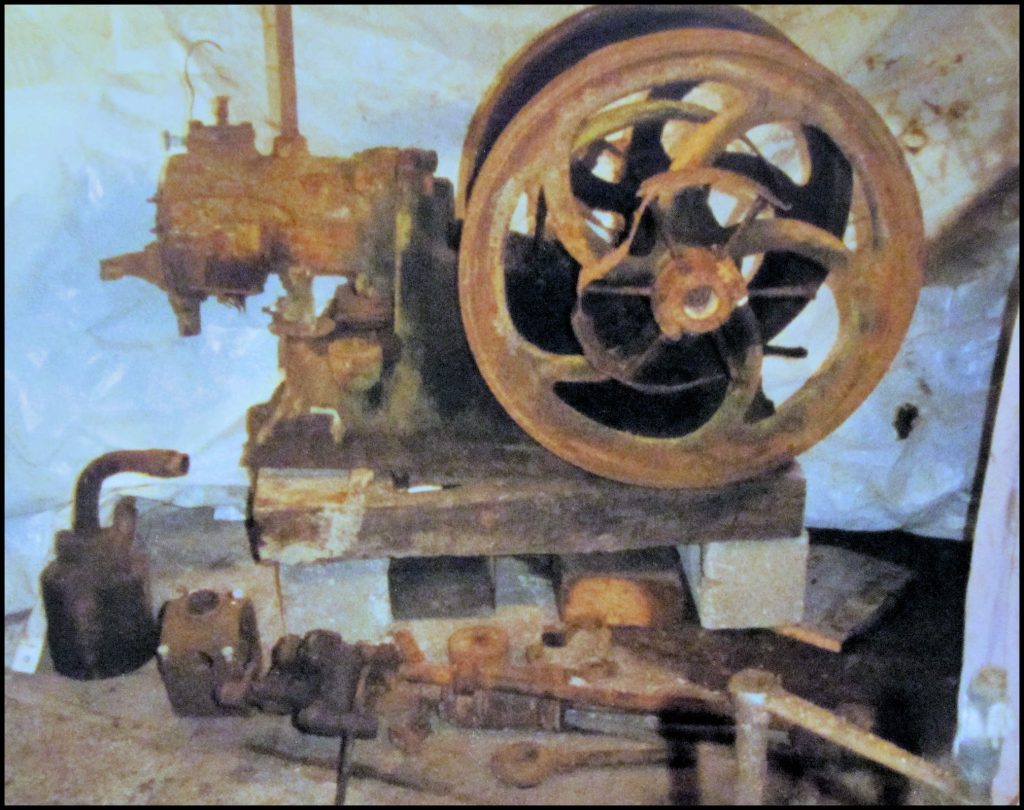
except for the hot-bulb. The main casting is fairly good,
but look at the state of the steel pulleys.
Photo by John Harrison.
The exhaust pot and heat shroud are o.k. and even the blowlamp can be made to work with a Iittle time and solder.
Our biggest problem is the hot-bulb – or rather lack of one. Can anyone either, sell or lend us one, even the latter would greatly assist as we won’t be able to prove our wives wrong unless we can restore the engine to running order!
We are certain that a photograph of this engine, in running order, will appear in this magazine, but not for a while!’

GENERATING FOR GRENADA
Stationary Engine Magazine
March 1987
Arnold Sayer tells how his restored Allan oil engine came to be used in the ‘Bulman’ TV series.
[‘Bulman’ was a crime drama series, principally written and created by Murray Smith, that first broadcast on ITV on 5 June 1985. The series, featuring retired ex-cop George Bulman (Don Henderson) and his assistant Lucy McGinty (Siobhan Redmond). Produced by Granada Television, Bulman ran for two series, with the final episode broadcasting on 8 August 1987.]
It all began with a telephone call from Granada Television to Tim Holt ‘manager’ of Cumbria Steam & Vintage Vehicle Society. Granada wanted to know if anyone had an antique generating plant which could be used in a TV programme. Tim gave them my telephone number and an appointment was made for a TV representative to view my engines and dynamos.
The generating set chosen comprised a 1916 lampstart Allan driving a 1900 open wound Crompton dynamo. The plant would be used in one episode of the “Bulman” detective series, with filming taking place at Downham Hall near Clitheroe, the home of Lord Clitheroe. It would be my duty to deliver the plant to the site and set it up ready for filming, then return the following day to show the actors how to start the engine.
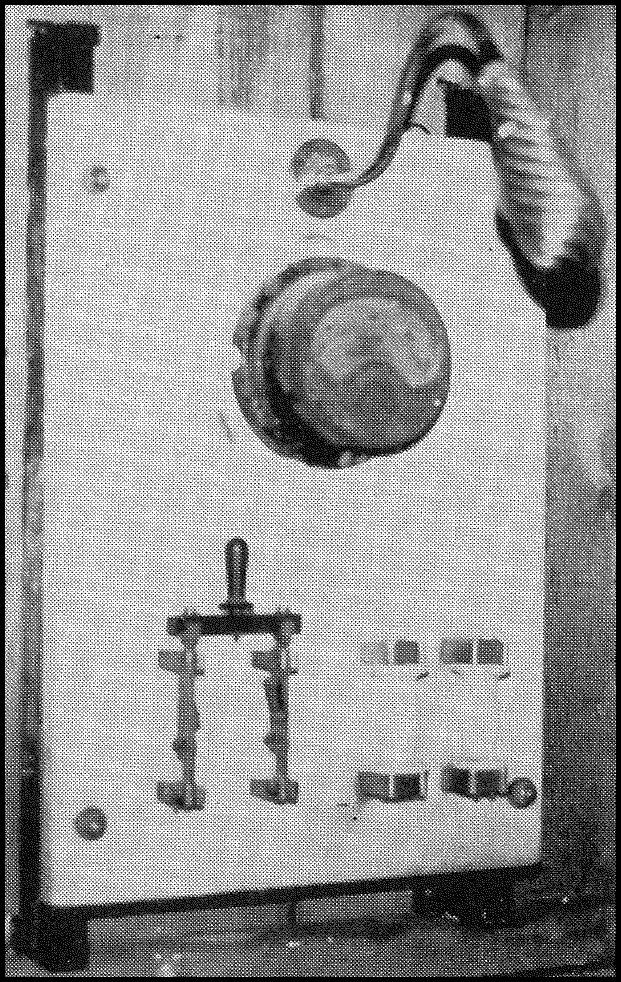
When the big day arrived I arose early and loaded the plant onto my trailer. In addition I threw aboard about 4cwt of equipment such as tools, jacks, crowbars and various pipes and cables. This acted as ballast and ensured that I never got above 3rd gear. I left home at 9.00am and arrived ‘on location’ at 11.30 to be met by Granada’s Alan Rutter. As the engine house was to be a large empty barn I was able to drive my car and trailer straight in, drop the ramps and unload. The plant was then jacked up and mounted on large breeze blocks. Two joiners arrived and quickly built an engine house around the plant. An old switchboard of the same era [pictured to the left] was then fixed to the wall and wired up. The special effects team were soon busy running a flexible pipe around the engine. This pipe had several small holes in it and was connected to a ‘smoke machine’ which, during the starting scene, would create enough smoke to indicate that the plant was very old and dilapidated! I produced some lengths of 2″ pipe and arranged an exhaust system which disappeared straight up into the rafters.
The engine was then started and everything checked prior to the big day.
On arrival at Downham Hall next morning I met the Director, film crew and other people involved with the filming. Then the actors arrived and I showed them how to start the Allan. I had to explain how the hot-bulb required heating with a blowlamp for ten minutes before it would start. After a short discussion it was decided not to use the blowlamp during filming as the roar of the lamp would drown any dialogue.
When the cameras eventually started rolling I had to bring the engine to the required temperature, switch off the blowlamp and nip quickly out of sight. I imagined it would be somewhat of a dicey operation because there would be a time lag while the actors spoke their lines. Any time lag would cool the hot-bulb, and I had visions of the engine refusing to start. All those expensive cameras working and twenty people involved, delays would be costly. I was worrying needlessly because the engine only failed once in fifteen starts. Bulman handled the starting handle very well and gave the impression he had been starting engines all his life.
Filming began at 11am and finished around 5pm. Although I spent about twenty hours on a project for a scene that will probably last less than a minute on the TV screen, however, I enjoyed the experience and met some interesting and competent people. The episode of “Bulman” may have appeared by the time you read this as it was destined for this winter’s series. If it hasn’t appeared, be sure to look out for it.

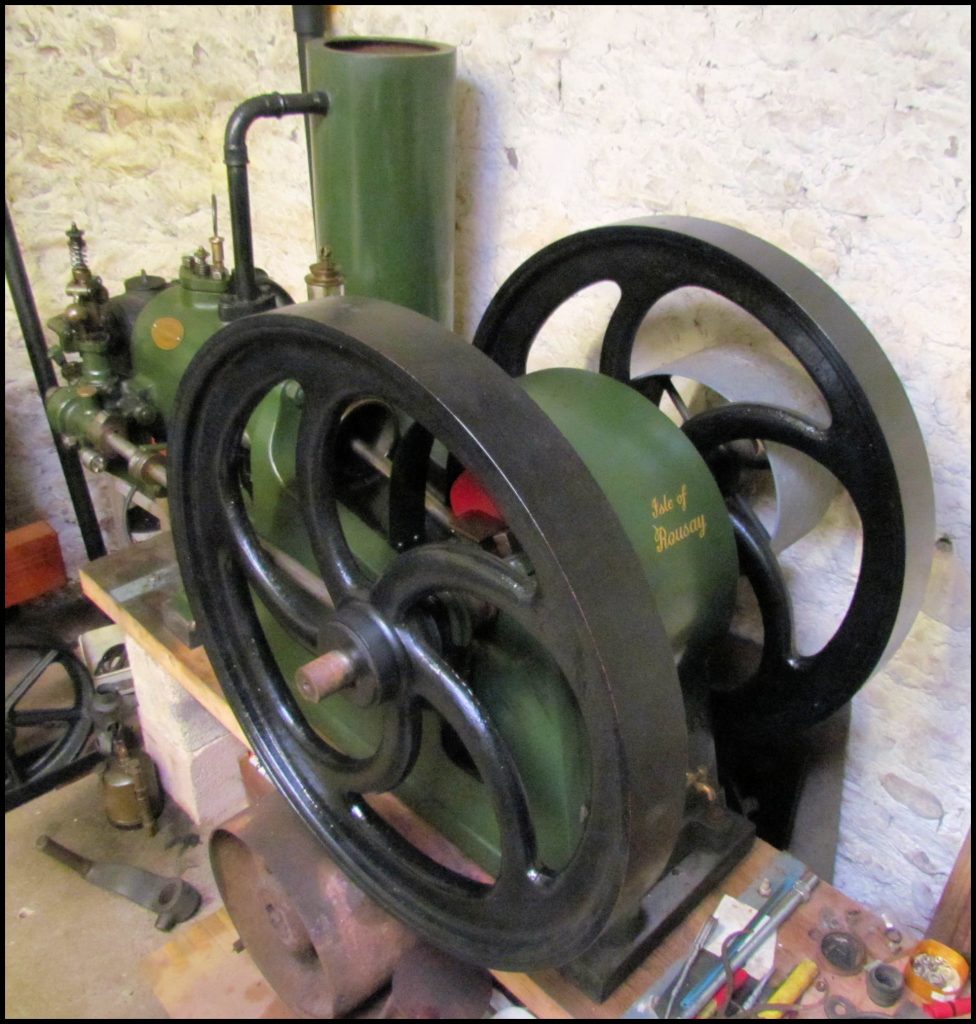
appears today. A superb craftsman for detail, you’ll see Arnold has also added
the ‘Isle of Rousay’ to its livery.
The photo above was taken in early 2019 when George Brown [on the right] travelled down to Kirkby Stephen in Cumbria to collect the engine from Arnold Sayer [second left]. Also in the picture are Neville Beaty and Charles Hamilton, who assisted George in loading the engine onto the trailer for transportation to its new home in Berwickshire.
[Again, my thanks to George Brown for sharing the story of this well-travelled engine.]
